This is the official report on the capsize of Contradiction in April 2005. Soon I will post my own reflections on what happened, although I agree with James’ conclusions and thank him for his kind words. I hope that other sailors will learn from this report – keep your hatches closed and have you flares in a capsize bottle in or near the cockpit. If your boat has a lifting keel make sure it is locked down!
This document is posted on the SA Sailing website here.
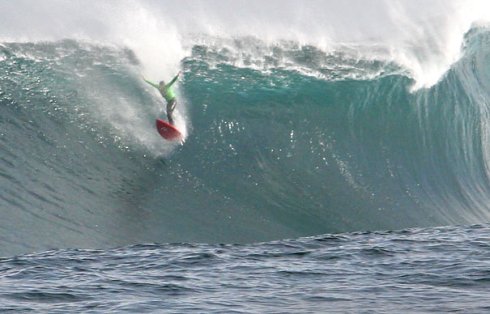
This photo was taken less than a mile from where the capsize took place! From the 2006 Big Wave Action held at Dungeons.
Findings of the official enquiry conducted on behalf of SAS by James Beaumont following the capsize and subsequent rescue of the sailing vessel “Contradiction” in Hout Bay on Saturday the 2nd of April 2005.
Summary of events:
On Saturday morning Contradiction, a 24 foot Lavranos day sailor, left the Hout Bay marina with two crew and the skipper, Max Ozinsky. The wind was blowing South East at about 20 knots and gusting to about 25 knots there was a light wind chop on the sea surface and very little swell in the bay. The water temperature was about 14º C. The yacht sailed out of the marina with two reefs in the main sail and a storm jib.
The yacht sailed to windward out of the bay and closer to the windward shore in order to avoid the lee shore on the opposite side. This brought the yacht close to Chapman’s peak where there is a pronounced, amplified “gust” tunnel.
The yacht was then hit by a very strong gust and broached. As the yacht went past 90º the retractable keel was pulled back into the keel box by the resultant gravity from the angel of heel going past 90º. This effectively nullified the ballast required to keep the yacht upright and, in fact, exacerbated the heel to the point where righting the yacht was impossible. The cockpit was flooded immediately. The companion way hatch was open and the wash boards were not in place which resulted in a substantial ingress of water into the body of the hull. It was not long before the yacht lay partially submerged, on her side, with the companion way fully submerged. The yacht remained afloat as a result of a small airtight chamber in the bow and an air bubble in the hull along the length of the side above the water.
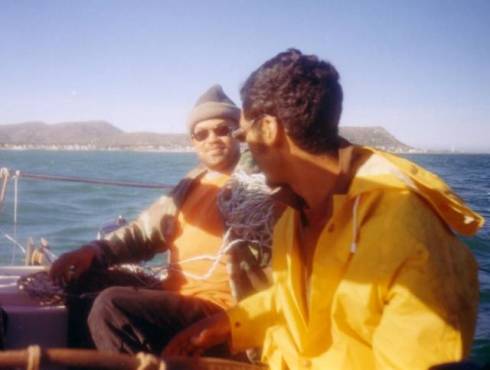
The crew Errol and Eddie kreefing on another occasion
The crew, who were all wearing life jackets, clung to the top of the hull to remain out of the water. The capsize bottle was not in the cockpit but down below in the cabin, which was now submerged. The skipper made several attempts to dive into the hull to retrieve the capsize bottle but was unsuccessful. The skipper was carrying a VHF radio but it failed to operate after being submerged.The alarm was raised by a tour bus operator from Chapmans Peak and a successful rescue of the crew and subsequent recovery of the yacht was conducted by the NSRI who are too be commended on a extremely well executed operation. Details of this are available from the NSRI.
The yacht was towed to the Hout Bay North Mole where it was righted and subsequently sunk completely apart from a small section of the bow (which was kept afloat by the airtight chamber) and the mast.
Having observed events from a high point up to that stage I then went down to the yacht and arranged for a crane and diver to recover the yacht. The yacht was subsequently re-floated and pumped dry. During this operation I interviewed the skipper.
Once the yacht had re-floated I inspected the vessel thoroughly.
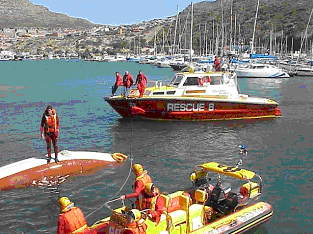
Contradiction on her side after being towed back to Hout Bay harbour by NSRI Station 8. Thanks again guys, we owe you big, big time!
Findings of Investigation:
The skipper:
The skipper is a very experience keel boat sailor and holds a SAS day skipper ticket (No. 1882). The skipper was fit and healthy on the day.
The conditions:
The conditions were such that only an experienced skipper, with experience of the bay, in a well founded vessel should have ventured out. I have seen the skipper venture out in these conditions before and he has handled his yacht well. I believe that as a skipper he was competent to handle the conditions on the day.
The sail configuration:
The sail configuration was congruent with the prevailing conditions.
The vessel:
I found the vessel to be very well equipped and maintained as well as having brand new suit of sails and a new outboard engine with sufficient power to drive the vessel in the conditions on the day. The skipper displayed a very good knowledge of his yacht.
Given the absence of sufficient built in buoyancy and the design of the lifting keel it is a matter of debate as to whether the yacht was sufficiently well founded for these conditions. With the benefit of hindsight and in the light of what happened, it is my opinion that the yacht is not suited to the conditions such as they were on that day.
Safety Equipment:
The yacht had all of the safety equipment required (and more) and everything was in good order and in date.
Certificate of Fitness:
The vessel’s CoF was issued in April last year and the skipper had already contacted the HBYC to arrange a new one. Analysis of the capsize:
Firstly one should note that most skippers sailing in Hout Bay have experienced broaches in the same area in question. It is a common event and not something to be alarmed about in its self. The capsize can be attributed entirely to the fact that the retractable keel retracted and in doing so rendered the yacht completely unstable and unable to operate within her design parameters. Had the keel not retracted I have very little doubt that the vessel would have righted and all would have been well. The fact that the companion way hatch was open and the wash boards not in place definitely contributed to the rapid partial submersion of the boat. Had this not been the case it might have been possible to enter the cabin to attempt to redeploy the keel before the hull became flooded, but I have my doubts. Had the cabin been closed however the yacht would not have flooded causing the yacht to submerge nearly as fast as it had.
More importantly, the fact that the safety bottle was stowed bellow decks made it impossible to raise the alarm given that the VHF radio had failed. One can assume that had the rescue not taken place in such a short space of time then the skipper would have, in all likelihood, made renewed attempts to retrieve the bottle, but one can not assume that he would have been successful.
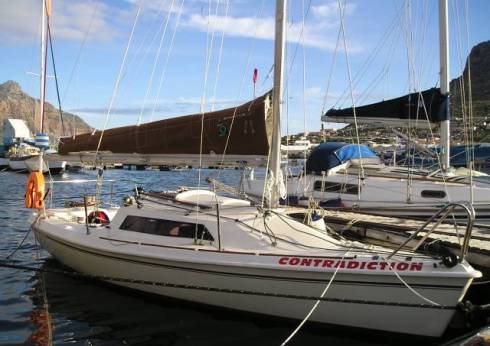
Contradiction on her mooring about 5 months before that day
Summary of the findings:
Firstly it should be noted that, given the facts that the radio was not working, the flares and ID sheet were inaccessible and the cold temperature of the water, the situation was potentially fatal (and I make this statement based on my own experience with the NSRI). Had the vessel been slightly further out to sea or had not been spotted so quickly the outcome could have been tragic and therefore this matter can not be taken lightly.
The cause of the capsize:
The capsize and subsequent partial submersion would not, in all likelihood, have taken place had the keel not retracted. I therefore attribute the cause of the capsize to be that fact that the keel was not locked in place. It should also be noted that the yacht does not have a facility to lock the keel in place.
The actions of the skipper:
The skipper, although qualified and experienced, failed in two areas:
- Failing to close the companionway hatch and secure the wash boards.
- Failing to bring the capsize bottle with emergency equipment into the cockpit.
It is pleasing to note that the crew were wearing life jackets. (Something I rarely see).
In terms of complying with the regulations I have found no transgressions.
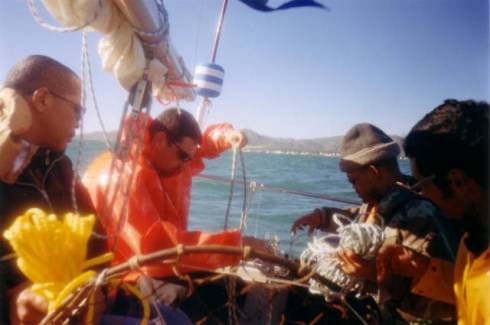
Kreefing off Kommetjie on Contradiction – Gorrie, Max, Errol and Eddie.
Conclusion:
Apart from the renewed evidence to substantiate the importance of safety equipment and the correct usage and stowage thereof one very import fact has emerged from this:It is absolutely critical that retracting keels can be locked in place and I am of the opinion that this should be made a standard requirement for the CoF for such vessels. I think that it is critical that all safety officers are made aware of this and the potential result of the absence of a keel lock.
In closing I would like to thank Max Ozinsky who, in spite of his ordeal, was humble, pleasant and extremely helpful throughout this investigation. Not traits yachtsmen are known for!
James Beaumont
SAS Safety Officer
06 April 2005
SAS Offshore Committee Comment and Recommendations.
The SAS Offshore Committee has reviewed the reports regarding the capsize of the L24 at Hout Bay and has the following comments / recommendations.
- The yacht had the requisite valid Certificate of Fitness and the skipper was suitably qualified to handle the conditions experienced.
- It is recommended that vessels with lifting keels of the L24 type are equipped with a mechanical means of locking the keel in whatever position is selected. SAS will include inspection for such devices in it’s Safety Checklist and the absence of such a devise will be regarded as a “no go” item.
- It is recommended that in sea conditions where the vessel is taking water into the cockpit the companion hatch is closed and companionway washboards are fitted.
- It is impractical to carry the “capsize bottle” in the cockpit of a small yacht but consideration should be given in this type of vessel to carrying a pencil flare pack that is small, waterproof and is easily attached to a point in the cockpit.
There are a few small mistakes in this report – “Contradiction” is a Lavranos 20, not 24. The radio was working when we left the harbour – we know because we did a radio check with Cape Town Radio, but despite being supposedly waterproof it did not survive 30 seconds and less than 50cm in the sea – bad one Icom! The hatch was closed, but the washboard was not in place.
I will write more in a post giving my views of what happened soon.

Leave a comment
Comments feed for this article